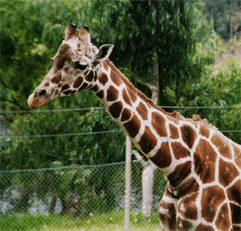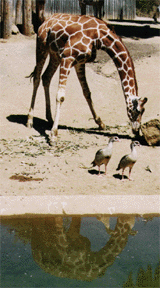 |
Animals that Stand Out in a Crowd by Lynn Hofland |
 |
Animals that Stand Out in a Crowd by Lynn Hofland |
Giraffes truly do stand out in a crowd. At the zoo or in their natural habitat of Central Africa, they tower above other beasts, and are the second largest land animals alive today (the African elephant is the largest). The length of the giraffe's neck has intrigued observers down through the years. "How did the giraffe get its long neck?," some ask.
On witnessing a 3-meter (10 foot) shoulder high giraff stretch its 2.5 meter (8 foot) neck to its limit, and then add almost another foot with its long grasping tongue for that seemingly out-of-reach branch high in an acacia tree, some might believe that the stretching process drove the growth process for the giraffe's neck. But really, is a giraffe capable of adding anything to its stature?
If one feature did change, would it not affect the whole? Let's consider the giraffe.
The giraffe is a mammal, therefore much of its anatomy is similar to that of other mammals. Like most other mammals, the giraffe has seven neck bones. What if it did not nave seven bones between the shoulders and the base of the skull? Man's short neck supports a perfectly balanced head in the erect posture with very little effort. The giraffe's huge head must be held aloft at all times. When standing, nearly half of its approximately 225-kilogram (500 pound) neck muscles are in tension. The amount of muscle required is directly related to the number of joints that must be supported. Reducing the joints to just two, at the skull and at the chest, would reduce the weight considerably and require less energy for survival. If the shortage of food drove the neck to change, would not the number of neck bones and joints be changeable also by such evolutionary processes? Of course the problem with this design would be a loss of flexibility, and would severely increase breakability if the giraffe received a blow to the head or neck.
In the same respect, having a megajointed neck would require the exact opposite - greater energy use and greater muscle mass to be supported. This would cause the giraffe's centre of gravity to shift ahead of the front legs when the head is extended straight forward, causing the hind legs to come off the ground - assuming the front legs were strong enough. Seven neck bones is excellent design.
With the head being so high in the air, the huge heart
of the giraffe must be capable of delivering sufficient oxygenrich blood
three meters (10 feet) up to the brain. This would be a problem (involving
too high blood pressure) when the giraffe was head-down drinking water,
were it not for a unique collection of reinforced artery walls, by-pass
and antipooling valves, a web of small blood vessels (the rete mirabile,
or 'marvelous net')' and pressure-sensing signals that keep adequate blood
flow to the brain at just the right pressure. Even to those who consider
this as just adaptation to high gravitational pressures in its cardiovascular
system, the giraffe is unique.
GRAVITY-SUITS
 |
|
Equally marvelous is the fact the blood does not pool in the legs, and a giraffe does not bleed profusely if cut on the leg. The secret lies in an extremely tough skin and an inner fascia that prevents blood pooling. This skin combination has been studied extensively by NASA scientists in their development of gravity-suits for astronauts. Equally helpful to prevent profuse bleeding is that all arteries and veins in the giraffe's legs are very internal.
The capillaries that reach the surface are extremely small, and the red blood cells are about one-third the size of their human counterparts, making capillary passage possible. It quickly becomes apparent that these unique facets of the giraffe are all interactive and interdependent with its long neck.
But there's more. The smaller red blood cells allow for more surface area and a higher and faster absorption of oxygen into the blood. This helps to retain adequate oxygen to all extremities, including the head.
The lungs work in conjunction with the heart to supply the giraffe with the necessary oxygen, but in a way that is unique to the giraffe. The giraffe's lungs are eight times the size of those of humans, and its respiratory rate is about one-third that of humans. Breathing more slowly is necessary in order to exchange the required large volume of air without causing windburn to the giraffe's rippled 3.6 meters (12 feet) of trachea. When the animal takes in a fresh breath, the oxygen-depleted previous breath cannot be totally expelled. For the giraffe this problem is compounded by the long trachea that will retain more dead air than man can inhale in one breath. There must be enough lung volume to make this 'bad air' a small percentage of the total. This is a physics problem that the giraffe has solved.
BIRTH OF GIRAFFE
To add to the wonder, the birth of a newborn giraffe seals the case for intelligent design. The new calf drops into life from 1.5 meters (five feet) up, as the mother is incapable of comfortably squatting to the ground, and to lie down during birth would be a sure invitation for a lion or other predator to attack the mother. As in all mammals, the head is disproportionately large compared to the rest of the body at birth, and it becomes a challenge to pass it down the birth canal.
The baby giraffe has the added challenge of having a very fragile long neck attaching it to the rest of its 70-kilogram (150-pound) newborn body. If the head came out first, the neck would surely break when the rest of the body fell on top of it. If the head came out last, the neck would surely break as the body weight attempted to jerk the head out of the mother. Such an apparent impasse is solved by the rear hips being much smaller than the front shoulders, and the neck is just long enough to allow the head to pass through the birth canal resting on the rear hips. The front feet exit first to break the fall on the rest of the animal. The head is supported and cushioned by the rear hips, and the neck is pliable, allowing a sharp bend around the front shoulders.
This is a perfect exit, that would be impossible in any other combination or with any other new length of neck. Within minutes the new calf is gracefully standing between the mother's legs. From birth to adulthood in just four years, the neck grows from being one-sixth to one-third of the giraffe's total height. Such growth is required for the animal to overcome its leg height and to bend to get a drink of water. The calf's first year of food is almost exclusively its mother's rich milk, which can be reached easily.
Ecologically, the giraffe is perfectly matched to its environment. There is need of a tree trimmer to keep the fast-growing shade trees from overshadowing the ground and killing the muchneeded grass that provides food for the other savanna animals. There is also need of a sentinel that can see above the tall grass and observe the movements of the predator cats. The giraffe is not only tall enough for this, but has excellent eyesight and a curious disposition. After warning other animals with several swishes of the tail, the giraffe boldly strides out of harm's way. The great body height, tough skin layers, deadly rear hoof kick, and long, rapid stride make the adult giraffe an undesirable prey for any carnivore.
To suggest that all of this could have evolved in one class of animal, lacking any conceivable close relatives, and becoming so developed solely due to a supposed lack of food at ground level, is preposterous. Should not others which feed at ground level, being vulnerable to big cats, and being bombarded by the same cosmic radiation, have achieved a more giraffe-like stature?
Interestingly, there are others that do feed from trees. The gerenuk gazelle of Africa has the longest neck in the family of gazelles, has a long tongue, and eats leaves from trees while standing on its hind legs. The markhor goat of Afghanistan climbs trees as high as 25 feet to eat leaves from trees. Other mammals do desire the leaves of trees but none of them will ever become giraffes, and the giraffe most certainly did not come from any other 'less-than-giraffe' animal.
We cannot know that conditions were the same in the past,
but the "need to survive by reaching ever higher for food" is, like so
many Darwinian explanations of its kind, little more than a post hoc speculation.
The fossil record confirms this, and the unique and marvelous design seen
in this animal verifies it. The praise, glory and honour goes to the giraffe's
Creator.
References
1. Percival Davis and Dean H. Kenyon, Of Pandas and People, Haughton Publishing Company, Dallas (Texas), 1989, p. 71.
2. Alan R. Hargens, Developmental Adaptations to Gravity/Cardiovascular Adaptations to Gravity in the Giraffe, Life Sciences Division, NASA Ames Research Center (California), 1994, p. 12.
3. Helen Roney Sattler, Giraffes, the Sentinels of the Savannas, Lothrop, Lee and Shepard Books, New York, 1979, p. 22.
4. Francis Hitching, The Neck of the Giraffe, Where Darwin Went Wrong, Ticknor and Fields, New York, 1982, p. 179.
LYNN HOFLAND, B.S.E.E., is an Environmental Test Engineer at NASA Ames Research Center, Mountain View, California. He and his wife home-school their three children, and started "Stiffneck Ministries" five years ago to provide a library of creationist material to other homeschoolers.
|
|
|